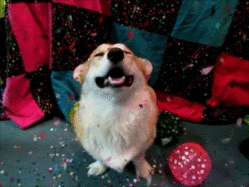
It’s the Lunar New Year, and as you may know, this year we are ushering in the Year of the Dog! The dog is the eleventh animal in the Chinese zodiac, which assigns an animal to each year in a cycle that repeats every twelve years. How did the cycle originate? Folk stories give different accounts, but the most popular version has to do with a race the animals held to see who could cross the river fastest in order to reach the Jade Emperor. Twelve different animals competed, and the dog came in second to last--not because he was slow, but because he was having too much fun playing and splashing around. That is the cutest and doggiest reason to lose a race ever, and indeed, dogs were prized in China for this very liveliness and sociability, two traits that are also thought to characterize people born during the Year of the Dog.
We’re celebrating the New Year by taking a look at just some of the roles dogs have played in art over the centuries. So fur the love of dog, sit, stay, and enjoy these doggos of art history.
1. Emotional Support for the Chinese Court
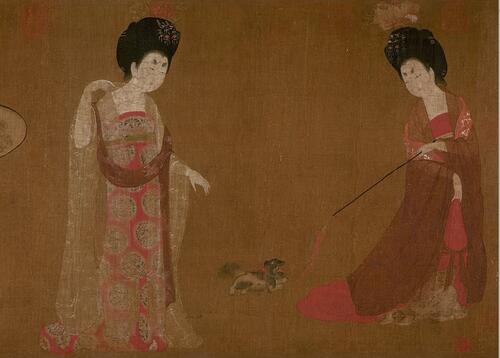 Zhou Fang. Ladies wearing Flowers in their Hair detail. Liaoning Provincial Museum, Shenyang.
Zhou Fang. Ladies wearing Flowers in their Hair detail. Liaoning Provincial Museum, Shenyang.
Zhou Fang (730-800) worked as a court painter during the Tang dynasty and is most notable for his silk paintings of elegant court ladies. Adhering to strict ideals of court behavior, the beautiful women drift through stately gardens, graceful and yet seemingly marked by ennui and loneliness. The only relief seems to come from playing with the little companion puppy scampering about by their feet with a feather duster. Indeed, whenever the pup is present in a painting, all eyes are directed toward him, and the women’s faces bear the trace of a smile. Who’s surprised? Not me! Dogs make everything better. In Imperial China this kind of lapdog was primarily an indicator of high social status, not just a source of emotional support, but dogs were also kept around the home because they symbolized familial harmony and procreation. According to one Chinese myth, after humankind was first created by the original humans, Nŭwā and Fúxī, the next animal they created was the dog. If you ask me, they clearly had their priorities in order.
2. Beloved Hunting Companion
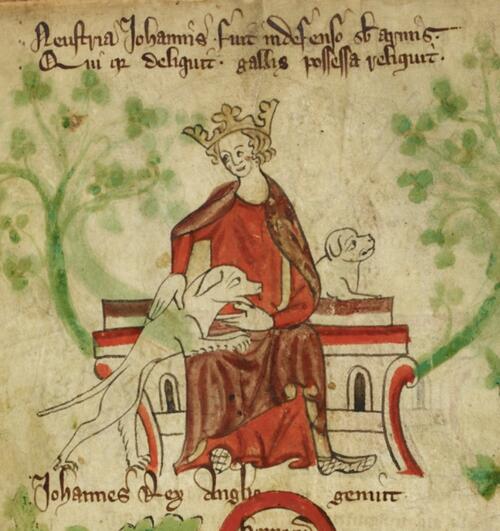
“Bad King John and One of His Hunting Dogs.” Royal MS 20 A II f 8v. British Library.
Even the most despotic rulers can’t resist a large dog who thinks he’s a lapdog! This surprisingly affectionate picture shows King John of England petting one of his favorite hunting dogs, who has started to climb onto his lap. Yes, that’s King John of such infamy that no other English king has been named John since. But surely he couldn’t be that bad if his dogs liked him that much, right? Right? (Or perhaps the manuscript artist was just trying to humanize him, in which case, smart move.) In most of Medieval Europe, people of noble birth were the only ones allowed to hunt, and they often kept large quantities of dogs on their various estates for that purpose. The fabulously wealthy art patron Jean Duc du Berry, for whom the Limbourg Brothers completed Les Tres Riches Heures, owned at least fifteen hundred dogs in the year 1388. That’s like a Crazy-Dog-Person level of dogs right there. But since he owned so many castles, it made sense to have a cohort of dogs at each. Even though pet and hunting dog portraiture may not have reached its sentimental zenith until the 19th century, by the number of affectionate portrayals of dogs found in illuminated manuscripts, it would seem they were of considerable importance to their medieval owners, too. After all, King John may have been bad, but his dog was certainly a heckin' good boy.
3. A Hufflepup who was a Good Finder
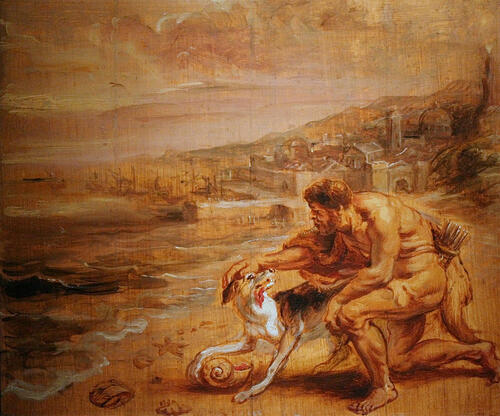
Peter Paul Rubens. Hercules’ Dog Discovers Purple Dye. Musée Bonnat, Bayonne.
According to Julius Pollux’s 2nd century Onomasticon, dogs have played an important role in the making of art, as well. One day Hercules was taking a walk along the beach of Tyre when his dog (a very good boy, I might add) sampled a spiky snail he found in the sand. Hercules, like the conscientious dog owner he was, panicked that the dog was getting into something dangerous, only to discover that the dog was perfectly fine, except that the particular mollusk he was munching on (possibly Murex brandaris) had dyed his mouth the most extraordinary color purple. This color would become known as Tyrian purple, an expensive dye favored by Roman emperors and Byzantine queens for centuries. Rubens painted this for King Philip IV of Spain’s hunting lodge as part of a series of three episodes from Hercules’ life, and perhaps he chose this moment because of the royal associations with dogs and hunting, as well as the color purple. Whatever the actual origins of Tyrian purple, however, I think we can all agree that discovering a color even when you are colorblind is just the sort of selfless thing a dog would do.
4. Guard Dog Extraordinaire
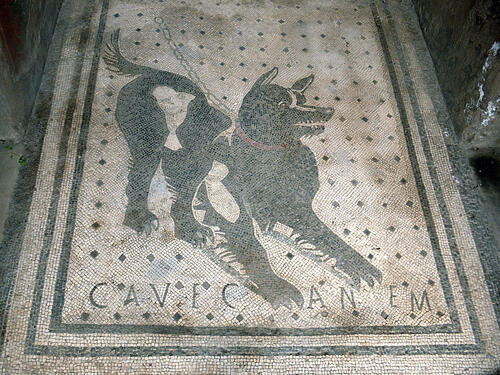
Cave Canem Mosaic. House of the Tragic Poet, Pompeii.
You know those metal signs you see affixed to chain link fences that say “BEWARE OF THE DOG” in large letters? Proving that there is nothing new under the sun, this is the Ancient Roman version of those signs, “Cave Canem” literally translating to “Beware of the Dog.” This vivid mosaic depicting a fierce guard doggo dates from sometime before 79 AD, when it was buried under volcanic ash after the eruption of Mt. Vesuvius. It was found on the floor in the vestibule of the so-called House of the Tragic Poet, where it no doubt warned many a would-be visitor or burglar of the dangerous beast that lurked within. At a time when there was no police force to speak of, many residences and taverns in Pompeii used dogs for protection, and the inclusion of mosaic images of the canines was likely helpful in a time when literacy was rare. It has been suggested that similar floor mosaics may have been utilized, not so much to ward away possible intruders, but to remind visitors to look where they are going and not step on small dogs kept as pets, as if to say, “Be aware of the dog… he has feelings, too.” And if that’s not the cutest thing the Romans ever did, I don’t know what is.
5. Friends for Life AND Death
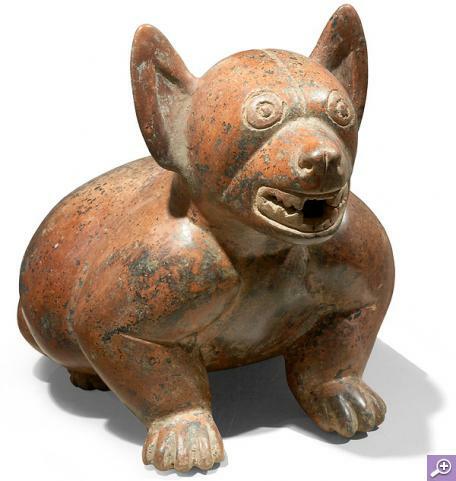
Colima. Dog Terra-Cotta with Red Slip. The Dayton Art Institute.
Invariably exuberant and chubby, hundreds of terra-cotta dogs such as this one have been discovered in burial sites in Northwestern Mexico, where the Colima culture thrived between 300 BC and 300 AD. This kind of native hairless dog was often kept as a pet, and they were valued for their companionship and the fact that they might make a tasty meal someday. Indeed, the dogs were fattened up for this purpose, and it is these chunky pups we see repeated over and over again in ceramic, sometimes scratching their ears or sitting in other cute poses. In Colima culture they were considered to be human beings oldest helper and friend, the creature that helped save the last person alive after a flood devastated the world. Some of these vessels are hollow inside, with a spout at the mouth, used for pouring water or other liquids, symbolically giving life. At the same time, however, these dogs were buried with the dead, likely to guard their remains and be their guide in the after life. These dogs were so faithful, they would stick around through a life cycle and beyond the grave, even after being eaten! That right there is the kind of loyalty only a pup can provide.
6. Companions of Goddesses

Giovanni Battista Gaulli. Diana the Huntress. Minneapolis Institute of Art.
Diana was the Goddess of the Hunt in Classical Roman mythology, and she is often depicted accompanied by her two dogs, Sirius and Phocion. Here she is reclining after the chase, a stag lying dead at her feet, while she surveys a hunting party of nymphs in the distance. Just as Diana’s barely clothed body is beautifully and solidly modeled, so too are her dogs rendered with substance and precision. Gazing serenely into the distance, the stalwart dogs seem to be remarkably in tune with their mistress, which must be one of the perks of having a god-like connection to your animals. (Diana: The Original Dog Whisperer.) The dogs are likely modeled after the dogs of Cardinal Pietro Ottoboni, the church official who commissioned the painting in 1690. Indeed, the Ottoboni heraldic device of the double-headed eagle can be seen on the greyhound’s collar. Thus, one way for Italian baroque patrons to immortalize their beloved hunting dogs was to paint them as the companions of Immortals.
7. Companions of People Pretending to be Goddesses
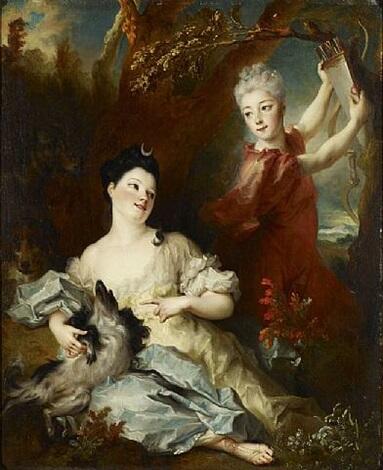
Sometimes little dogs take on bigger roles in allegorical images than they bargained for. This often occurred in the 18th century, which saw a trend in portraiture of sitters taking on the guises of mythological characters. Like many of his contemporary continental artists, De Larguillierre had a standard repertory from which his sitters would be able to choose. Diana was a popular choice, as it emphasized a young lady’s purity and pulchritude. Of course, when a genteel young lady gets to be painted as the Goddess of the Hunt, she gets to include her own dog as her hunting companion. But that doesn’t mean that dog is a hunting breed. In fact, usually it’s not. Usually it’s a lapdog. One result is this rather hilarious portrait of a marquis’ daughters and their fluffy little pup getting a belly rub. And you better believe there’s a close up, the better to appreciate that bulgy eye.
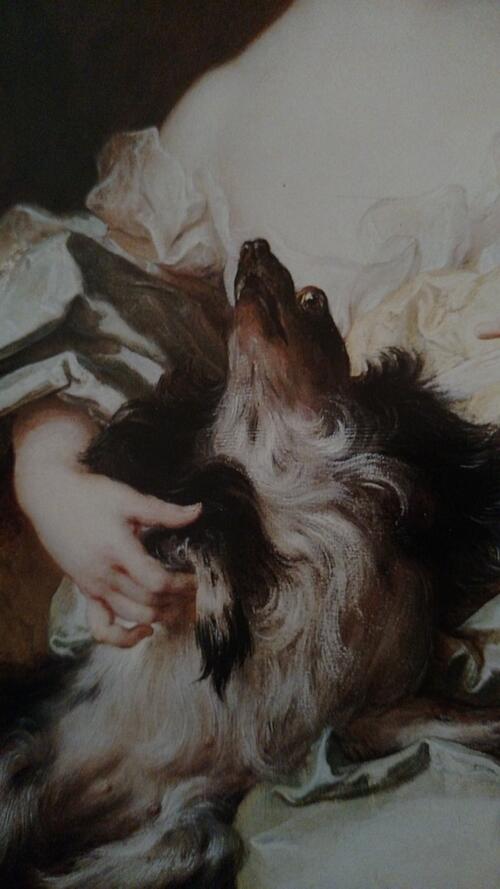
Maybe it’s actually a small spaniel, not a lap dog. Maybe it’s howling because it senses the quarry. Or maybe it’s a saccharine painting of a beloved member of those girls’ family getting some really good pit scratchies.
8. Heralds of the Saints
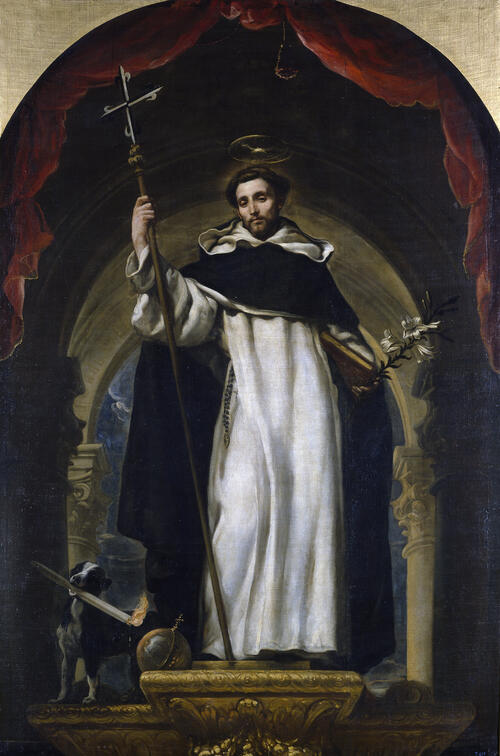
Claudio Coello. St. Domingo de Guzman. Prado National Museum.
If you ever see a dog next to a monk in white and black robes, you know you’re looking at a painting of St. Dominic, the Spanish priest who founded the Dominican order in 13th century France. The dog is St. Dominic’s attribute because when Dominic’s mother was pregnant with him, she reportedly had a vision in which she gave birth to a dog bearing a flaming torch. (First of all, ow.) Naturally, she sought help for interpreting this dream, and a local Benedictine monk told her that it meant her child would bear the flame for Christ in this world. Dominic certainly took up that mantle, but I regret to say it’s possible that all this dog business actually boils down to a Latin pun having to do with the name of the Dominicans, which can be parsed to mean “Dogs of the Lord,” a name which certainly evokes loyalty and vigilance. Whatever the truth may be, Images of St. Dominic and the dog abound in stained glass windows, manuscripts, and even on tombstones. This is an especially fine painting from Baroque Spain following the height of the Counter-Reformation, and just take a look at that joyful dog, proudly carrying that torch in his mouth like its his most beloved stick. You know he’s an extra good boy because he’s taking special care not to set St. Dominic’s billowing robes on fire. That’s A+ torch work, Mr. Pupper.
9. Symbols of Fidelity

Jan van Eyck. The Arnolfini Portrait. National Gallery, London.
Fashions may fade (and I’m looking directly at you, giant top hat and faux preggo padding), but there is one thing and one thing only that will always be in style: a cute dog. Luckily for the Arnolfinis, Toto over here fits the bill. While this painting has been subjected to endless interpretation, common consensus is that a marriage proposal or contract of some sort is transpiring, which gives the dog two very likely meanings. One is that of fidelity in marriage, because dogs are so loyal. Part of that loyalty also meant remaining chaste before marriage, as symbolized in the single flame of the chandelier. But what comes after marriage? You guessed it: procreation. And it looks like Signor Arnolfini’s going to take a leaf out of Toto’s book and bury his proverbial bone. Further evidence that the dog may represent marital lust lies in the open, red bed curtains, and the oranges by the window sill, symbolic of fertility. Even if this pupper, described with just enough detail to feel like a portrait, was actually just a family pet, Jan van Eyck uses him here to embody his family’s connubial ideals and goals. That’s a lot weight on his tiny fluffy shoulders, but just imagine him darting around that well-appointed interior, nipping and yipping at a whole bunch of Arnolfini babies! (Ok, so It’s not clear if they ever had any children, but it’s still a very cute thought, assuming the kids took after their mother.)
10. The Purest Thing in the World

Franz Marc. Dog lying in the Snow. Staedel Museum.
Expressionist and co-founder of The Blue Rider, Franz Marc sought in art and philosophy a bridge to the spiritual world. He found that bridge in his theoretical work on color in combination with his most frequent subject: animals, whom he believed to be innocent and primal, and therefore closer to God and Nature. This is his own pet, Ruthie, painted in a harmony of blue, which he considered the masculine, intellectual principle, and yellow, the feminine and joyful. She is a creature perfectly in concord with nature, pure as the snow on which she makes her bed.

And Marc was right. There is nothing as pure as dogs. The human mind cannot grasp their love. They are quite simply the best, and we do not deserve them.
Sources
- Bowron, Edgar Peters. “An Artist’s Best Friend: Dogs in Renaissance and Baroque Painting and Sculpture.” In Best in Show: The Dog in Art from the Renaissance to Today. New Haven: Yale University press, 2006.
- Impelluso, Lucia. Nature and Its Symbols. Translated by Stephen Sartarelli. Los Angeles: Getty Publications, 2004.
- Keister, Douglas. Stories in Stone: A Field Guide to Cemetery Symbolism and Iconography. Salt Lake City: Gibbs Smith, Publisher, 2004.
- Lipshulz, Sandra Lawall. Selected Works: The Minneapolis Institute of Arts. Minneapolis: Minneapolis Institute of Arts, 1988.
- Sotheby’s New York. Important Old Masters Paintings: The Property of the New-York Historical Society. January 12, 1995. [auction catalog]
- St. Clair, Kassia. The Secret Lives of Color. New York: Penguin Books, 2016.
- Tschen-Emmons, James B. Artifacts from Ancient Rome. Santa Barbara: Greenwood, 2004.
- Welch, Patricia Bjaaland. Chinese Art: A Guide to Motifs and Visual Imagery. Rutland, Vermont: Tuttle Publishing, 2008.
- “The Discovery of Purple.” Musée des Beaux Arts, Bayonne. Accessed January 20, 2018. http://webmuseo.com/ws/musee-bonnat-helleu/app/collection/record/1923?v…$$
- “Colima Dog.” Dayton Institute of Art. Accessed January 17, 2018. http://www.daytonartinstitute.org/art/collection-highlights/pre-columbi…
- “Dog Lying in the Snow, ca. 1911.” Staedel Museum. Accessed January 20, 2018. http://www.staedelmuseum.de/en/collection/dog-lying-snow-ca-1911










Wishing all the good puppers a happy new year!